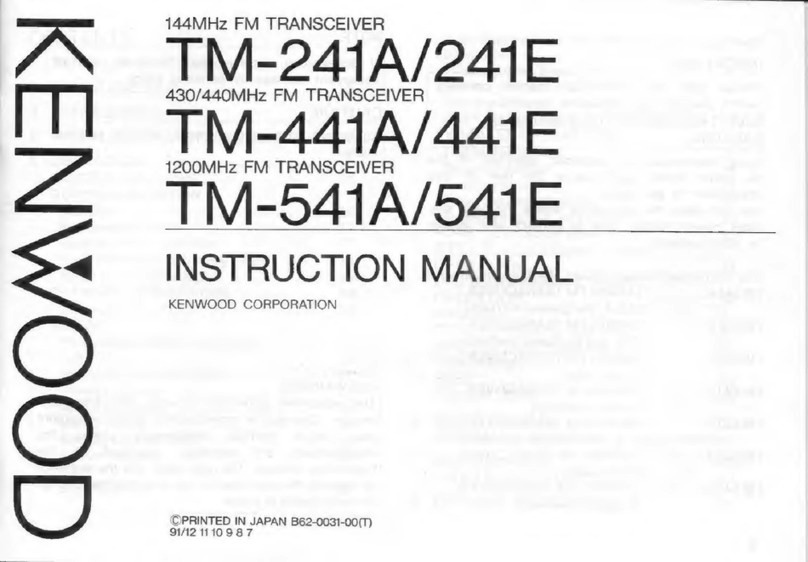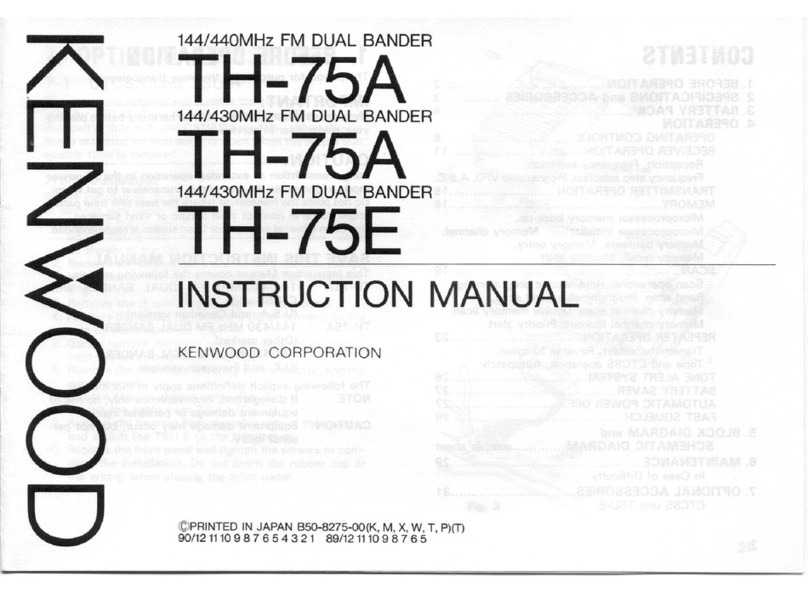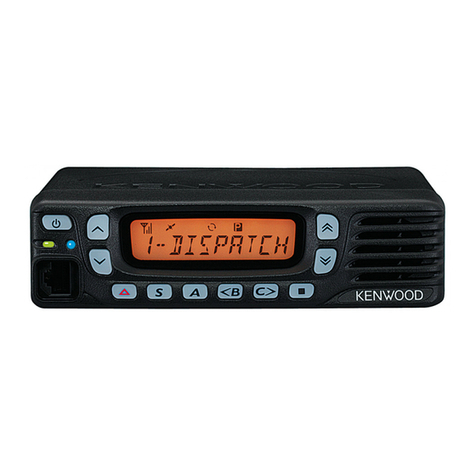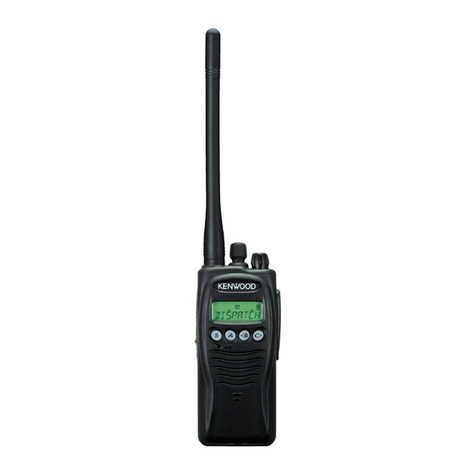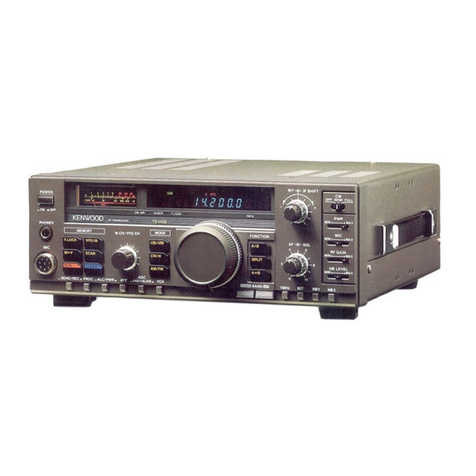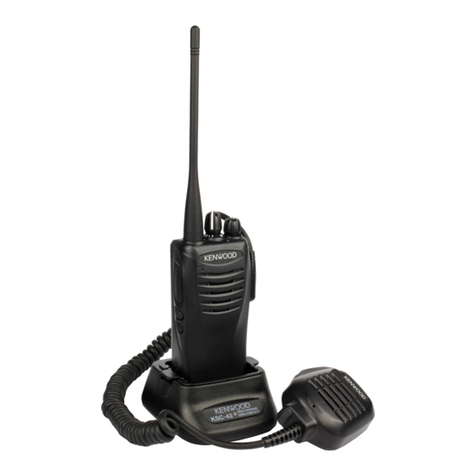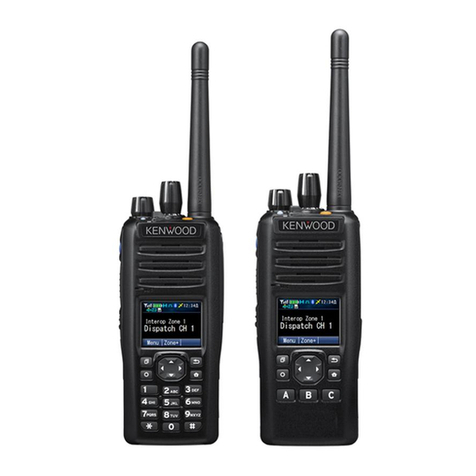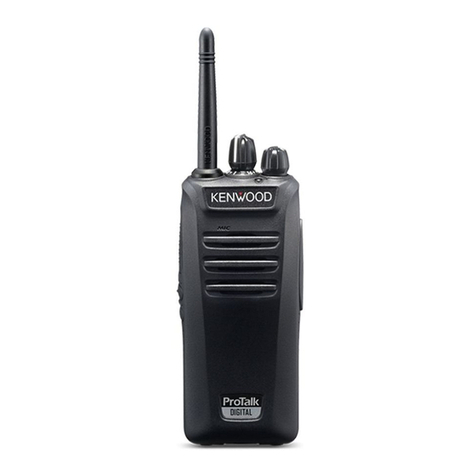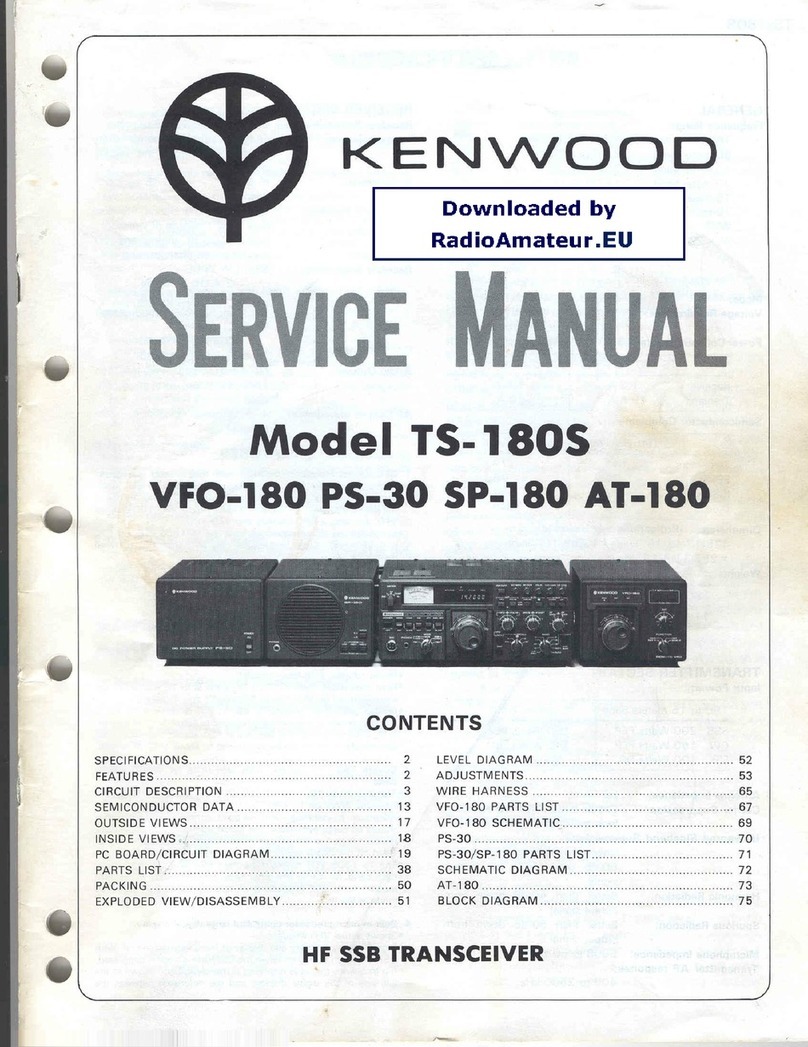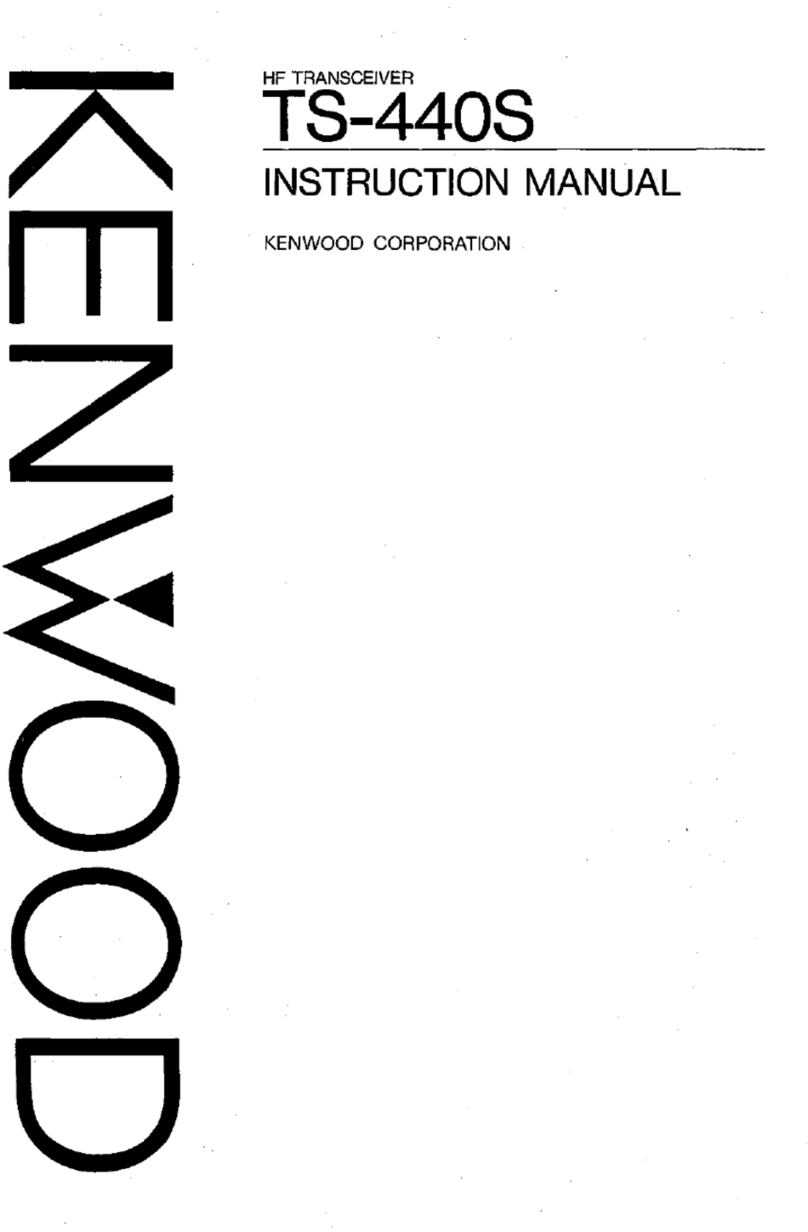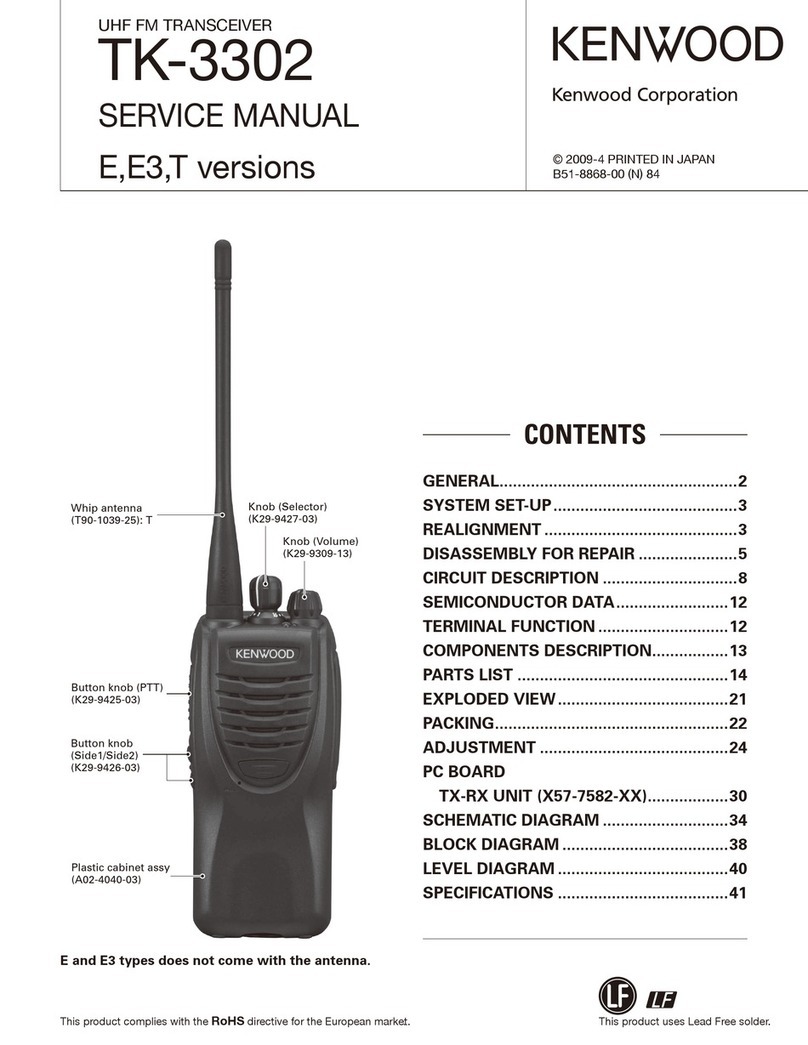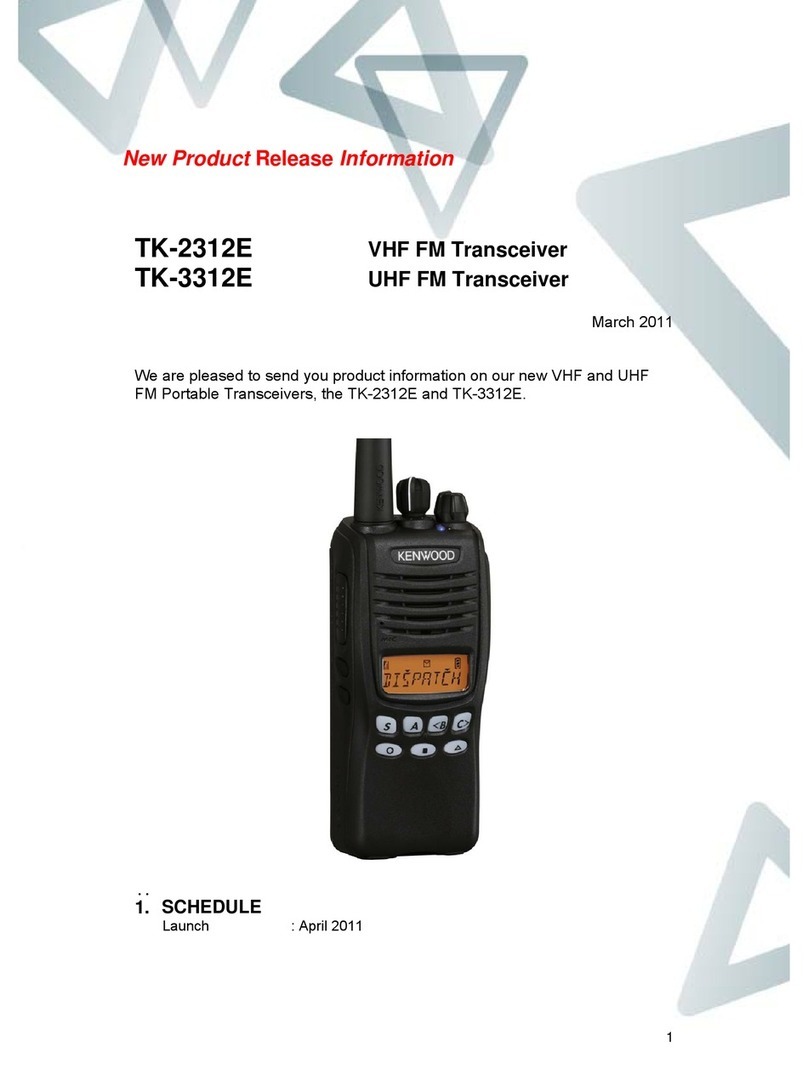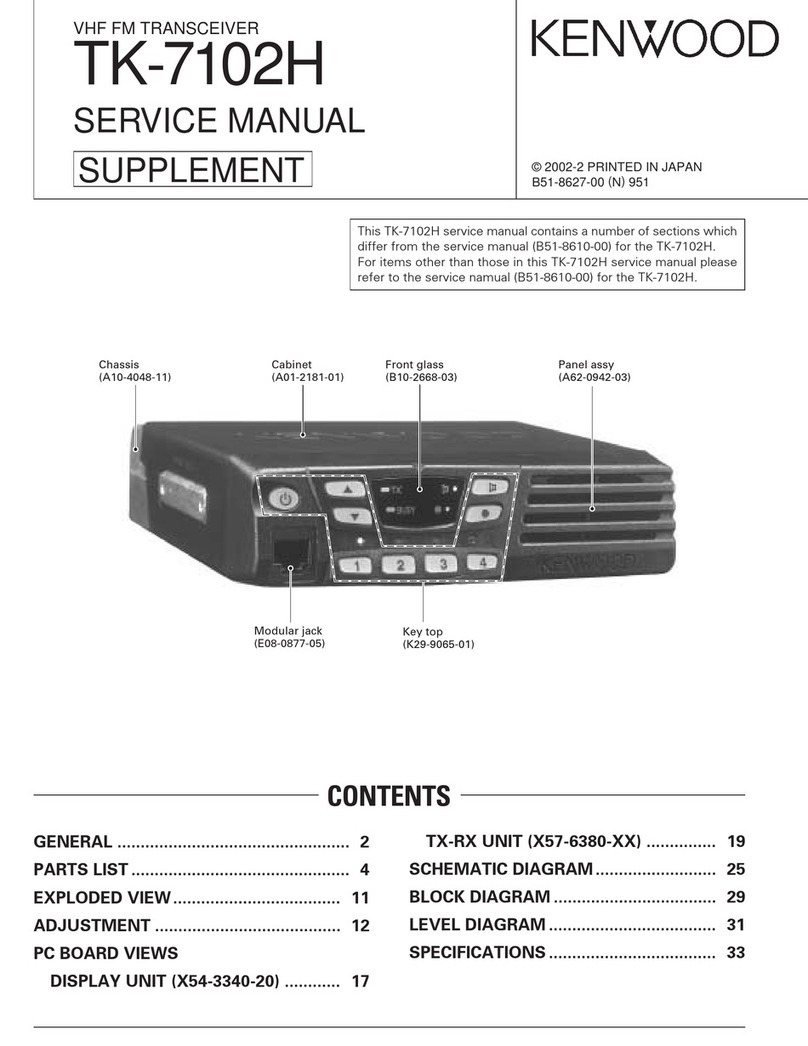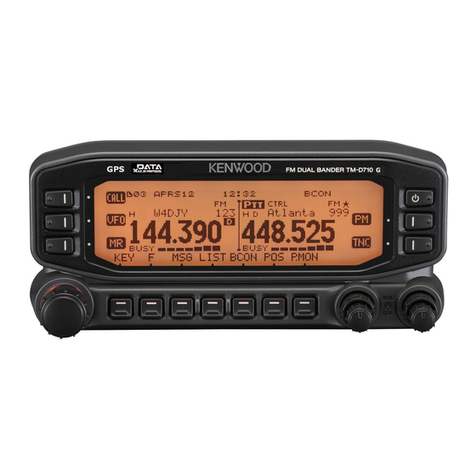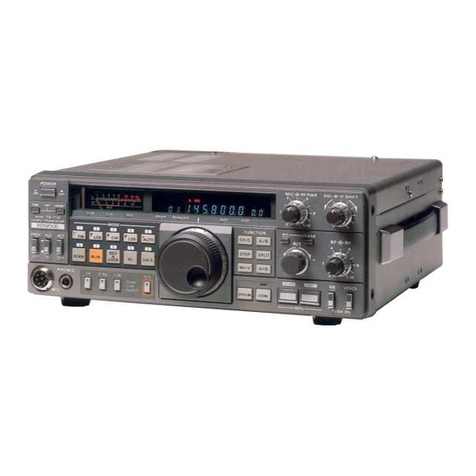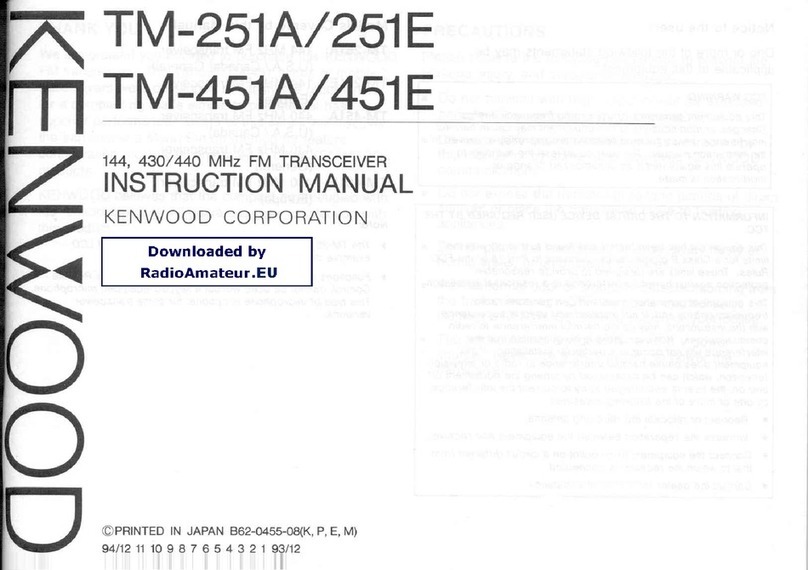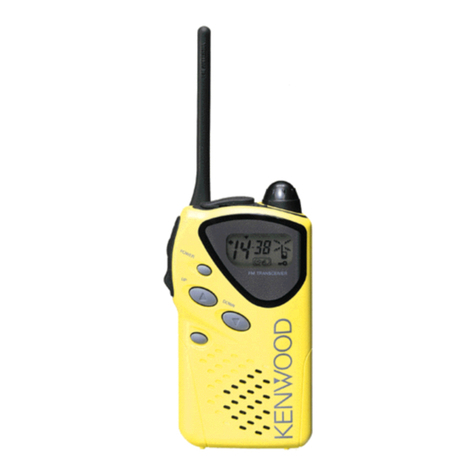
TM-321A TM-321A
CIRCUIT DESCRIPTION
Transmitter system
@General
In the transmitter system the desired frequency is pro-
duced directly by an oscillator. Frequency modulation is
obtained directly thru the use of avaractor diode.
@Modulation circuit
Audio signals from the microphone are applied to a
three-stage operational amplifier which adds preemphasis,
performs amplification and limiting, and includes asplatter
filter to remove undesired high-frequency components.
After amplification by the operational amplifier, part of
the audio signal is applied to the microphone check circuit
used in the low-power mode.
In the FM modulation circuit, the frequency of the
VCO is directly modulated by avaractor diode.
q
¥
RS
Ra
RM H/C
METER
Roe ae
TX-RX UNIT
TO FINAL UNIT
@Preamplifier stage circuit
The output from the VCO enters the linear amptifier,
which is capable of high-quality signal amplification
because it operates entirely in linear mode, APC, (Auto-
matic Power Control) is performed by controlling the
collector voltage of the 3stage fina! preamplifier stage.
@Power amplifier circuit
The drive signal is applied to the power module and
amplified to the required fevet. In the model TM-321A
heat is dissipated efficiently by alarge mechanically strong
heatsink,
@APC and SWR protection circuits
Fig. 3shows the basic ALC (Automatic Level Control)
and SWR (Standing Wave Ratio) protection circuits. The
SWR protection circuit incorporates aCM coupler that
detects any reflected power caused by mismatching of the
antenna. After detection and amplification, this circuit
acts to lower the output contro! voltage, which protects
the power module by reducing the gain. The automatic
power control (APC) circuit incorporates adiode that is
used to detect aportion of the output from the power
module. The detected signal is amplified and is then used
to control the power control voltage. The control voitage
is inversely proportional to the output, so aconstant
output level is maintained.
FINAL UNIT
Fig. 3APC and SWR protection circuits
Table 3Power module M57774 absolute maximum ratings
(Finat unit Q1)
CIRCUIT DESCRIPTION
PLL synthesizer
Fig. 4is the PLL system block diagram. The trans-
mitter and. receiver systems of the TM-321A has independ-
ent VCOs and PLLs, but share acommon low-pass filter.
The VCOs are configured as subunits. This construc-
tion minimizes outside influence and improves frequency
stability.
DATA
CLOCK
para
LPF
age
013,14 (c2
Meag5gP
TXVCO
FCONT
03
1SV166
To provide 5, 10, 15, 20, and 25kHz steps, acom-
parison frequency of 5kHz is obtained by dividing the 12.8
MHz frequency of the reference oscillator by 2560. In
both the transmitter and receiver systems the target
frequency is produced directly by the VCO, passed through
one amplifier stage, then applied to apulse-swallow PLL IC
that divides the frequency, performs phase comparison,
and ocks the frequency.
The reference frequency division ratios (four values)
and comparison frequency divison ratio are supplied to
the PLL IC (M54959P) as external serial data. An internal
dual-modulus (1/128 and 1/129) prescaler enables the
entire pulse-swallow PLL circuit to be implemented on
asingle chip. (See Fig. 5.) The switching functions
(SW1 and SW2) of the PLL IC are used to switch between
the 8R (receive) and 8T (transmit) operating voltages
in the transmit and receive modes.
The switch controls are applied together with frequency
division ratio data from the Control unit.
RESET
ait £13(12.8MHz)
2SC2714
2SC2714
a2
ZSK5O8
APC
OIFF. AMP RE PRO/APC CONTROL Sw AMP
RX 189,175~194.170MHz
at a2 8T fat Nout: ai7
DRIVE 28C2712 28C2757 28C2714
+8 AVR
4
(oS) TX 220, 224 Hz
RX VCO
FCONT
aa
2SK508
se
1SV166
DRIVE (X59-3120-11)
Q20 ANT
PRO
RF
APC SND (OB
TX-RX UNIT
us Ros ves 10 VCO (X58-3000-11}
TRI
Fig. 4PLL system block diagram To unlock contro! circuit
12.8MH
178 divider HH trier divider vices 12.8MHe
4Comparison fr
(72it binary}
TIN Programmable divider] fIN/N To LPF
(10-bit binary)
VCO nput 2-modulus 7fio 2
prescaler Dats latch {21-bit}
(1/128, 1/128)
21
5Shift regiver (21-bit)
NUL
Low
sk
15
kdetect
osc
by 2560 Veo
frequency phase 1
1/A divider selection detector
21 cutee counter b- Latch signal
3
aa:
Specifications
Item Symbol Unit Condition
(°c) M57774
Veo 25 17
Operating voltage
Current consumption Iec 25 7
Input power pin 25 2G6=ZL=502 0.6(Vec, $12.5V)
Output power Po 25 ZG=Z=502 40
Case temperature (operating) Telop) °c -30~+110
°c -40~ +110
Storage temperature Tstg
Tc AMP
2
13
4
Beta input
from Control unit
Fig.5 PLL IC ;M54959P block diagram
To8T TosR
control control
circuit circuit
TM-321A TM-321A
CIRCUIT DESCRIPTION
Transmitter system
@General
In the transmitter system the desired frequency is pro-
duced directly by an oscillator. Frequency modulation is
obtained directly thru the use of avaractor diode.
@Modulation circuit
Audio signals from the microphone are applied to a
three-stage operational amplifier which adds preemphasis,
performs amplification and limiting, and includes asplatter
filter to remove undesired high-frequency components.
After amplification by the operational amplifier, part of
the audio signal is applied to the microphone check circuit
used in the low-power mode.
In the FM modulation circuit, the frequency of the
VCO is directly modulated by avaractor diode.
q
¥
RS
Ra
RM H/C
METER
Roe ae
TX-RX UNIT
TO FINAL UNIT
@Preamplifier stage circuit
The output from the VCO enters the linear amptifier,
which is capable of high-quality signal amplification
because it operates entirely in linear mode, APC, (Auto-
matic Power Control) is performed by controlling the
collector voltage of the 3stage fina! preamplifier stage.
@Power amplifier circuit
The drive signal is applied to the power module and
amplified to the required fevet. In the model TM-321A
heat is dissipated efficiently by alarge mechanically strong
heatsink,
@APC and SWR protection circuits
Fig. 3shows the basic ALC (Automatic Level Control)
and SWR (Standing Wave Ratio) protection circuits. The
SWR protection circuit incorporates aCM coupler that
detects any reflected power caused by mismatching of the
antenna. After detection and amplification, this circuit
acts to lower the output contro! voltage, which protects
the power module by reducing the gain. The automatic
power control (APC) circuit incorporates adiode that is
used to detect aportion of the output from the power
module. The detected signal is amplified and is then used
to control the power control voltage. The control voitage
is inversely proportional to the output, so aconstant
output level is maintained.
FINAL UNIT
Fig. 3APC and SWR protection circuits
Table 3Power module M57774 absolute maximum ratings
(Finat unit Q1)
CIRCUIT DESCRIPTION
PLL synthesizer
Fig. 4is the PLL system block diagram. The trans-
mitter and. receiver systems of the TM-321A has independ-
ent VCOs and PLLs, but share acommon low-pass filter.
The VCOs are configured as subunits. This construc-
tion minimizes outside influence and improves frequency
stability.
DATA
CLOCK
para
LPF
age
013,14 (c2
Meag5gP
TXVCO
FCONT
03
1SV166
To provide 5, 10, 15, 20, and 25kHz steps, acom-
parison frequency of 5kHz is obtained by dividing the 12.8
MHz frequency of the reference oscillator by 2560. In
both the transmitter and receiver systems the target
frequency is produced directly by the VCO, passed through
one amplifier stage, then applied to apulse-swallow PLL IC
that divides the frequency, performs phase comparison,
and ocks the frequency.
The reference frequency division ratios (four values)
and comparison frequency divison ratio are supplied to
the PLL IC (M54959P) as external serial data. An internal
dual-modulus (1/128 and 1/129) prescaler enables the
entire pulse-swallow PLL circuit to be implemented on
asingle chip. (See Fig. 5.) The switching functions
(SW1 and SW2) of the PLL IC are used to switch between
the 8R (receive) and 8T (transmit) operating voltages
in the transmit and receive modes.
The switch controls are applied together with frequency
division ratio data from the Control unit.
RESET
ait £13(12.8MHz)
2SC2714
2SC2714
a2
ZSK5O8
APC
OIFF. AMP RE PRO/APC CONTROL Sw AMP
RX 189,175~194.170MHz
at a2 8T fat Nout: ai7
DRIVE 28C2712 28C2757 28C2714
+8 AVR
4
(oS) TX 220, 224 Hz
RX VCO
FCONT
aa
2SK508
se
1SV166
DRIVE (X59-3120-11)
Q20 ANT
PRO
RF
APC SND (OB
TX-RX UNIT
us Ros ves 10 VCO (X58-3000-11}
TRI
Fig. 4PLL system block diagram To unlock contro! circuit
12.8MH
178 divider HH trier divider vices 12.8MHe
4Comparison fr
(72it binary}
TIN Programmable divider] fIN/N To LPF
(10-bit binary)
VCO nput 2-modulus 7fio 2
prescaler Dats latch {21-bit}
(1/128, 1/128)
21
5Shift regiver (21-bit)
NUL
Low
sk
15
kdetect
osc
by 2560 Veo
frequency phase 1
1/A divider selection detector
21 cutee counter b- Latch signal
3
aa:
Specifications
Item Symbol Unit Condition
(°c) M57774
Veo 25 17
Operating voltage
Current consumption Iec 25 7
Input power pin 25 2G6=ZL=502 0.6(Vec, $12.5V)
Output power Po 25 ZG=Z=502 40
Case temperature (operating) Telop) °c -30~+110
°c -40~ +110
Storage temperature Tstg
Tc AMP
2
13
4
Beta input
from Control unit
Fig.5 PLL IC ;M54959P block diagram
To8T TosR
control control
circuit circuit

